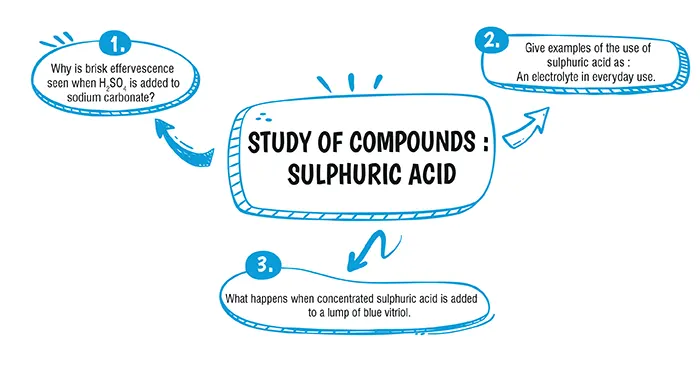Table of Contents

Ans. (d) Dibasic acid
Explanation:
H_2SO_4 when dissolved in water shows the following reactions:
H_2SO_4 + H_2O ⇌ H_3O^+ + H_SO_4^-\\
HSO_4^- + H_2O ⇌ H_3O^+ + SO_4^-\\
Since it forms hydronium ions with water, i.e., it donates H^+ ion. Therefore, it is acidic in nature. Also, it donates two H^+ in two stages; therefore, it is dibasic in nature. Hence sulphuric acid is a dibasic acid.
Ans. (C) Oleum
Explanation:
Oleum is a common name of a compound having molecular formula H_2S_2O_7. This compound is also known as pyrosulphuric acid. It is produced during the manufacturing of sulphuric acid in the contact Process.
Explanation:
When sulphuric acid is added to sodium carbonate it liberates carbon dioxide which produces brisk effervescence.
Explanation:
(i) In lead accumulators or in storage batteries.
(ii) In the manufacture of other acids like nitric acid, hydrochloric acid and phosphoric acid.
(iii) For cleaning metals before enamelling, electroplating and galvanising, as a pickling agent.
Explanation:
When concentrated sulphuric acid is added to hydrated copper sulphate, it loses its water of crystallisation and thus white anhydrous copper (II) sulphate is formed. In other words, The blue coloured hydrated (II) sulphate turns white due to the loss of water from crystallisation.
\underset{\text{hydrated copper sulphate (Blue crystals)}}{CuSO_4.5H2O} + \underset{\text{Conc}}{[H_2SO_4]} \rightarrow \underset{\text{Anhyrous copper sulphate (White crystals)}}{CuSO_4} + [H_2SO_4.5H_2O]
Download Mind Map of this chapter
Download NowWant to Practice Mock Tests of this chapter
Practice NowDownload Important Questions of this chapter
Download Now| Chapter No. | Chapter Name |
|---|---|
| Chapter 1 | Periodic Properties and Variations of Properties |
| Chapter 2 | Chemical Bonding |
| Chapter 3 | Study of Acids, Bases and Salts |
| Chapter 4 | Analytical Chemistry |
| Chapter 5 | Mole concept and Stoichiometry |
| Chapter 6 | Electrolysis |
| Chapter 7 | Metallurgy |
| Chapter 8 | Study of Compounds : Hydrogen Chloride |
| Chapter 9 | Study of Compounds : Ammonia and Nitric Acid |
| Chapter 10 | Study of Compounds : Sulphuric Acid |
| Chapter 11 | Organic Compounds |
| Chapter Wise Important Questions for ICSE Board Class 10 Chemistry |
|---|
| Periodic Properties and Variations of Properties |
| Chemical Bonding |
| Study of Acids, Bases and Salts |
| Analytical Chemistry |
| Mole concept and Stoichiometry |
| Electrolysis |
| Metallurgy |
| Study of Compounds : Hydrogen Chloride |
| Study of Compounds : Ammonia and Nitric Acid |
| Study of Compounds : Sulphuric Acid |
| Organic Compounds |
CBSE Important Questions Class 10
ICSE Important Questions Class 10
CBSE Important Questions Class 10
ICSE Important Questions Class 10